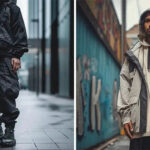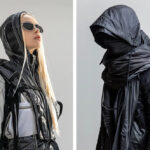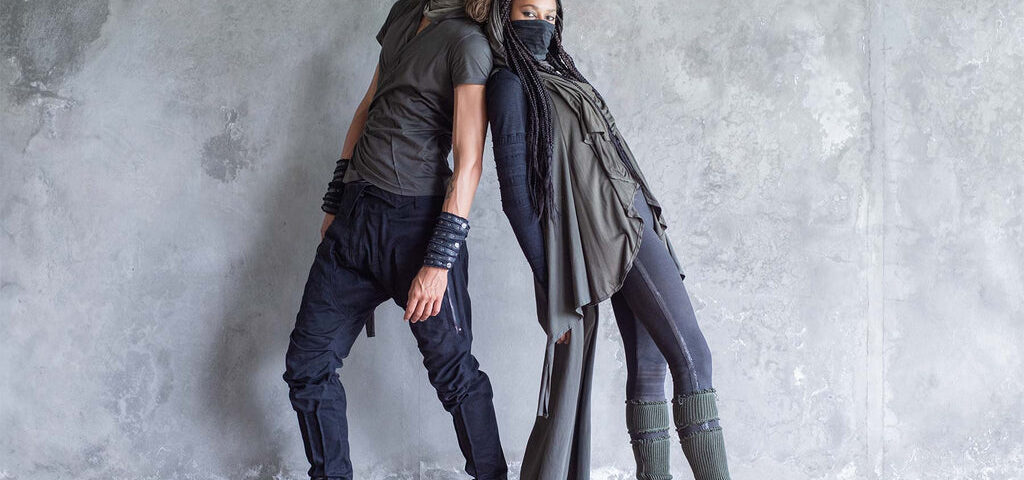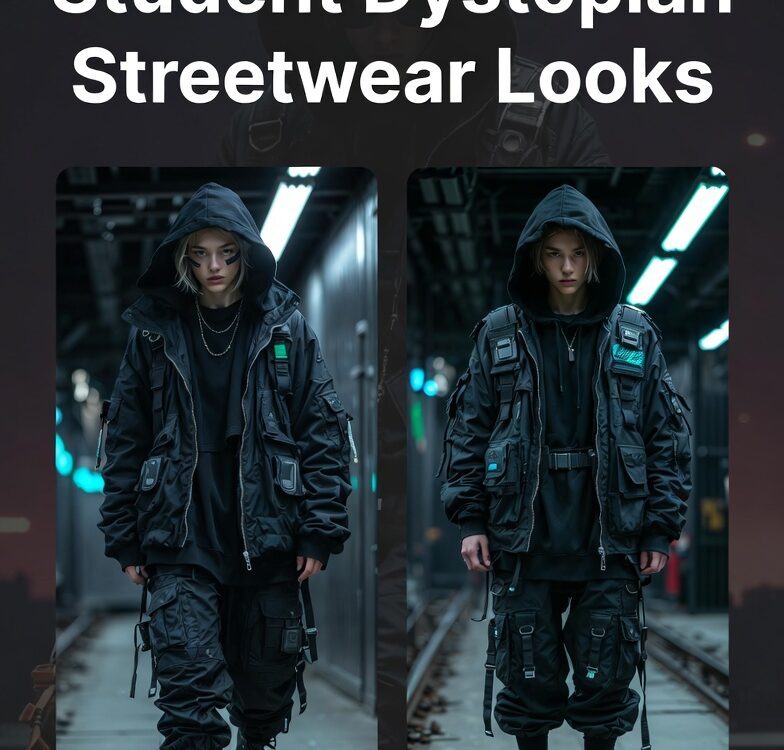
Cyberpunk streetwear vs techwear
April 29, 2025
How to Style Dystopian Streetwear: Grunge Layers, Utility Gear, and Attitude
April 30, 2025Fashion from the Fallout
In recent years, urban fashion has seen a dramatic shift toward a gritty, edgy aesthetic known as dystopian streetwear. This rising trend takes cues from post-apocalyptic worlds—fusing functionality with futuristic rebellion. Inspired by survival gear, cyberpunk aesthetics, and military silhouettes, dystopian fashion reflects a deep cultural shift. As society grapples with climate crises, economic uncertainty, and digital overload, this style serves as both armor and expression.
In this article, we’ll explore the origins, features, cultural impact, and future of dystopian streetwear and why it’s becoming a dominant force in urban fashion culture.
The Origins of Dystopian Streetwear
Dystopian fashion didn’t appear overnight. It emerged at the crossroads of several powerful movements:
1. Cyberpunk and Sci-Fi Influence
Films like Blade Runner, Mad Max, and The Matrix have left an indelible mark on fashion. Their depictions of ruined cities, tech-dominated futures, and resistance fighters shaped how we imagine post-apocalyptic style. Oversized coats, distressed fabrics, techwear, and tactical boots are now street staples.
2. Punk and Anti-Establishment Fashion
The anti-authority stance of punk culture also influenced dystopian streetwear. DIY elements, distressed materials, and rebellious slogans speak to a non-conformist attitude, echoing dissatisfaction with modern systems.
3. Military and Utility Wear
From cargo pants to combat boots, the inclusion of military gear in streetwear isn’t new—but dystopian fashion pushes this further. Think modular clothing, tactical vests, and multipurpose backpacks designed for function as much as form.
Key Features of Dystopian Streetwear
What makes a look “dystopian”? Here are the hallmark characteristics:
1. Neutral and Monochrome Palettes
Earth tones, black, grey, army green, and metallics dominate the color palette. These reflect decay, ruin, and survival instincts rather than bright, optimistic aesthetics.
2. Layering and Oversized Silhouettes
Layered clothing creates depth and function. Long coats, oversized hoods, and baggy pants convey protection against harsh environments. This style also references traditional ninja and samurai gear—frequently found in Japanese streetwear.
3. Distressed and Recycled Materials
Ripped fabrics, raw seams, patchwork, and visible repairs highlight imperfection and sustainability. Brands are embracing upcycled materials to reflect a world where resources are scarce.
4. Tactical and Techwear Integration
Techwear—a sub-genre of fashion with water-resistant materials, adjustable straps, hidden pockets, and futuristic functionality—forms the backbone of dystopian streetwear. It’s not just about looks; it’s about readiness.
5. Face Masks, Goggles, and Headgear
Even before COVID-19, dystopian fashion included face coverings, gas masks, and cyberpunk goggles. Now, these pieces feel more relevant than ever—blending fashion with functional protection.
Cultural Significance: A Mirror to Modern Anxieties
Why is dystopian streetwear gaining traction, especially among youth and artists?
1. A Reaction to Global Instability
Climate disasters, economic downturns, pandemics, and surveillance states are not just sci-fi themes—they’re reality. Dystopian fashion captures a generation’s sense of urgency and unease.
2. Digital Alienation and Technological Obsession
As technology becomes intrusive, fashion reflects that with wearable tech, face-obscuring accessories, and identity-masking gear. This speaks to a desire for anonymity in the digital age.
3. Sustainability and Anti-Fashion Sentiment
The fast fashion industry faces increasing criticism. Dystopian streetwear often uses sustainable, upcycled, or repurposed materials, challenging the wasteful cycle of mainstream trends.
4. Expression of Individuality and Resistance
Dystopian streetwear is gender-fluid, experimental, and rebellious. It enables individuals to craft unique looks that challenge norms and reject consumerist fashion cycles.
Notable Brands and Designers Leading the Movement
Many independent and high-end designers are at the forefront of dystopian streetwear:
1. Acronym
A Berlin-based brand known for its high-tech, cyber-warrior aesthetic. With a focus on functionality and futuristic design, Acronym is a key player in blending fashion and utility.
2. Rick Owens
Often referred to as the “Dark Lord of Fashion,” Rick Owens incorporates avant-garde cuts, dark romanticism, and post-apocalyptic vibes into his collections.
3. Y-3 by Yohji Yamamoto x Adidas
This collaboration merges Japanese minimalism with futuristic sportswear—streamlined silhouettes and layered techwear rooted in practicality.
4. Guerrilla Group
A Taiwanese brand producing tactical fashion with a focus on military aesthetics, cryptic typography, and modular functionality.
5. 11 by Boris Bidjan Saberi
An experimental brand known for its distressed fabrics, military influences, and monochrome tones, blending art and street fashion.
Dystopian Streetwear in Music and Pop Culture
This aesthetic has found its way into music videos, album covers, and stage performances. Key figures embracing dystopian fashion include:
-
Kanye West (Yeezy line with a rugged, stripped-down post-apocalyptic vibe)
-
Billie Eilish (oversized, androgynous, masked looks)
-
Travis Scott (grunge-meets-futurism style with tactical influences)
-
Grimes (cyberpunk fairy with ethereal yet dark tones)
Even K-pop idols and anime-inspired creators have embraced dystopian visuals, further embedding the style into global youth culture.
The Role of Social Media and Digital Influence
Platforms like Instagram, TikTok, and Pinterest are key to the rise of dystopian fashion. Influencers, cosplayers, and fashion-forward creators are sharing daily fits inspired by post-apocalyptic worlds, often paired with urban backdrops, concrete jungles, or abandoned buildings.
Hashtags like #DystopianStyle, #Techwear, #UrbanSurvivalWear, and #CyberpunkFashion have garnered millions of views. The intersection of fashion and digital culture has made dystopian looks more accessible than ever.
Future of Dystopian Streetwear
As we move deeper into the 2020s, the dystopian aesthetic is likely to evolve:
1. Sustainable Techwear
We’ll see more brands integrating eco-friendly, smart fabrics—like temperature-regulating textiles or self-cleaning gear—to match growing concerns around sustainability and health.
2. Virtual Dystopian Fashion
With the rise of the metaverse and digital fashion, many brands are launching virtual collections. Post-apocalyptic skins and NFTs are already popular in gaming and digital environments.
3. More DIY and Customization
The trend leans heavily toward individual expression, and more people are customizing their own gear—using thrifted clothes, patches, and handmade accessories to create unique dystopian fits.
How to Style Dystopian Streetwear
For those looking to adopt this style, here’s a basic guide to get started:
Essential Pieces to Include:
-
Tactical cargo pants or utility joggers
-
Oversized or asymmetrical outerwear
-
Combat boots or high-top sneakers
-
Face mask, goggles, or headwrap
-
Harnesses, belts, and utility pouches
-
Layered black and grey tops
-
Distressed or upcycled pieces
Styling Tips:
-
Keep the color palette muted
-
Mix synthetic and natural textures
-
Prioritize comfort, movement, and utility
-
Use accessories like straps, buckles, and rings to enhance the look
-
Add a touch of cyberpunk with glowing accessories or LED details
FAQs
Q1: What is dystopian streetwear?
Dystopian streetwear is a fashion trend inspired by post-apocalyptic, cyberpunk, and survivalist themes. It features tactical gear, oversized silhouettes, dark tones, and techwear elements.
Q2: How does dystopian fashion differ from regular streetwear?
While streetwear focuses on casual, trendy clothing, dystopian fashion adds a layer of functionality, resistance, and futuristic appeal, often using modular and sustainable materials.
Q3: Is dystopian fashion expensive?
It depends. Designer labels can be costly, but DIY fashion, thrifting, and upcycling make it accessible on a budget.
Q4: Can I wear dystopian style every day?
Yes. Many people incorporate subtle dystopian elements—like utility vests or monochrome fits—into everyday outfits for a more toned-down but edgy look.
Q5: What is the future of dystopian streetwear?
Expect it to evolve with sustainability, smart fabrics, and digital fashion experiences leading the next phase.
Conclusion: More Than Just a Trend
Dystopian streetwear is more than a fleeting aesthetic—it’s a cultural reflection, a survival instinct, and an artistic rebellion. In a world defined by disruption, uncertainty, and evolution, this style gives wearers a voice, a shield, and a way to express their individual and collective realities.
As urban fashion continues to adapt, expect to see dystopian elements woven deeper into streetwear, blending survivalism, sci-fi imagination, and avant-garde design into something powerfully human.



